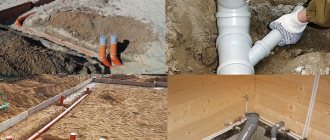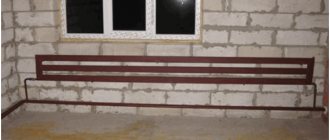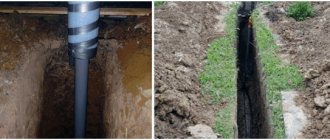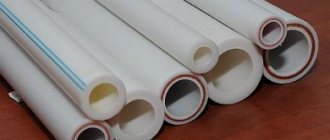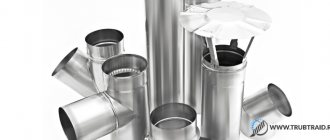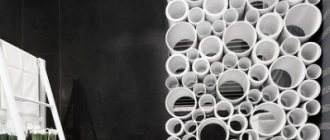If you buy good pipes, the sewer system will last for decades. In the article we will tell you how and which pipes to choose.
Three factors play a role in pipe selection: material, pipe location, and fittings. The material of the pipes determines their reliability and durability.
Depending on the location: for external and internal sewerage, the requirements differ. External sewerage - underground on the street. The inner half goes underground and half comes from toilets, sinks and showers throughout the house.
The availability and range of fittings have a lesser influence on the choice of pipes, but they determine the ease of installation of the sewer system. Let's first consider two types of sewerage: internal and external.
External sewerage
The external sewer system runs underground on the street and carries wastewater to the septic tank. Pipes for external sewerage can withstand static and dynamic loads:
- soil pressure,
- movement of people
- traffic,
- groundwater movement,
- temperature changes,
- humid environment,
- aggressive environments.
Dynamic loads. These are all variable loads: movement of cars and people, movement of groundwater. Pipes with high ring stiffness can withstand dynamic loads well.
Static loads. These are loads that constantly put pressure on the pipeline: soil pressure. Products with high ring rigidity also resist pressure well. Static loads also include others; we will consider them separately.
Temperature changes. The most dangerous are cold snaps, since many pipes can withstand 30-degree heat, but cannot cope with 30-degree frost.
Therefore, sewerage pipes are placed below the freezing level of the soil and are made frost-resistant. The freezing level is different for each region. For the Leningrad region, for example, 1.16−1.71 meters - depending on the type of soil.
Wet environments. High humidity in spring and autumn destroys ferrous metals without anti-corrosion coating and some other materials. Groundwater movement can dislodge the pipeline if it is not installed correctly.
Aggressive environments. These are acids, salts and alkalis that are found in soil and wastewater. Therefore, pipes inside and outside must be resistant to various substances.
Technical requirements for the sewer pipeline
In the general sewer system in any house there are two interconnected parts - external and internal. For each of them, pipes must be selected taking into account the requirements of GOST and SNiP. Let's talk about the differences between internal and external sewerage pipes.
External sewerage pipeline
The external sewer system has its own characteristics, so it is important that it is highly resistant to both static and dynamic loads. In other words, such products must perfectly withstand mechanical stress, deformations that may occur when vehicles drive, people move, and also freely withstand the mass of soil that is laid on top. It is with these parameters in mind that it is worth determining which pipe for sewerage into the ground should be used. All connections of pipeline parts must be as strong as possible and ensure complete absence of breaks so that the integrity of the pipeline is not compromised under any circumstances.
According to SNiP 2.04.03-85, in the external sewerage pipeline, pipes must lie below the level of soil freezing determined by specialists. It is important to consider that it differs in different parts of the country. In most cases, for a private house it is located at a depth of 0.5-2 meters. This indicator determines which pipes are best to choose for sewerage in a particular case.
In places located at the intersection with a road where cars regularly pass, durable pipes are used for sewerage. They must cope well with high loads.
Internal sewerage pipeline
Pipes that can be used for indoor sewerage do not have to meet such high requirements for strength and reliability. As a rule, they are laid under various decorative elements, as well as directly in building structures. Regardless of the sewerage layout, it is not subjected to such high loads as external ones. However, when choosing which pipes for indoor sewerage are better, you should focus on the following characteristics:
- resistance to high or low temperatures, aggressive chemicals, pressure;
- a smooth surface from the inside that will not interfere with the free flow of wastewater;
- Possibility of connection with parts of external sewerage.
These requirements are specified in SNiP 2.04.01-85. In addition, another important factor is the ability to quickly and easily install, as well as replace the damaged section of the sewer system, if the need arises. Taking into account the listed requirements, many owners of private houses choose pipes made of polyethylene, which are convenient to work with, as well as metal-plastic ones.
Internal sewerage
Internal sewerage runs in the house itself and is connected to the external one under or through the foundation. For the internal pipeline, rigidity is not so important; the load on it is several times less. But other general requirements remain:
- Durability. Nobody wants to change the pipeline every two or three years. Especially when there are materials with a service life of 50 years or more.
- Easy replacement. To replace old sewers, major repairs are carried out. It is better if the pipeline can be easily replaced in case of breakdown.
- Soundproofing. Pipes for internal sewerage must isolate the sounds of sewage movement from the inhabitants of the house.
- Ease of installation. Some plastic pipes can be easily installed by a non-professional. The easier the installation, the faster the sewer construction takes place.
- Non-toxic. Pipes must be non-toxic and not release toxic substances upon contact with wastewater.
- Smooth inner surface. The sewer will silt and become clogged if the inner walls of the pipes are rough.
In addition, the internal and external water pipes must be easily connected to each other. If they do not connect well, the joint between them will become clogged or leak. This is especially important when partially replacing the pipeline.
Go ahead. Let's consider which pipes are most suitable for sewer systems:
- PVC pipes,
- PE pipes,
- PP pipes,
- asbestos-cement,
- concrete,
- cast iron,
- ceramic.
Black smooth HDPE pipe - easy cable installation.
Laying cables in buildings requires a large number of bends, tight fastening to the surface and good protection from mechanical damage. Smooth black HDPE pipe is indispensable when laying utilities, installing video surveillance networks, alarm systems, etc. Laying flexible pipes is very easy, both indoors and on the external walls of buildings. Light pipes are very easy to lift to a height using only ladders. The use of smooth HDPE pipes guarantees complete protection of the cable from all adverse influences, in addition, a high level of safety is ensured in terms of insulating electrical wires from people. The walls of the pipes are resistant to temperature and provide the proper level of fire safety for electrical wiring.
Electricians enjoy the lightness and flexibility of the pipes, which can be quickly installed and fastened together. Pulling cables along them is also not difficult. When setting up networks, there are often situations when the cable is stretched incorrectly, resulting in it not being enough. You have to re-tighten the entire cable, which damages the walls and ceilings. If the cable was pulled inside HDPE pipes, then re-tensioning it is not a problem - it takes just a minute. It is very convenient that such pipes can be laid at smooth angles or with a large number of bends. The walls are connected using light welding equipment. When welded, the joint becomes monolithic, so seam divergence is an extremely rare occurrence.
PVC pipes
PVC or uPVC - polyvinyl chloride, a new polymer material. PVC pipes are lightweight, environmentally neutral and easy to install.
Advantages:
- long service life,
- no overgrowth,
- resistance to acids,
- wear resistance,
- ease.
Flaws:
- inoperability at temperatures below −10°C,
- deform (elongate) at temperatures above 60°C.
Gray PVC pipes are excellent for indoor sewerage, where they are used. Red PVC pipes for sewerage with hardness SN-4 and higher can be used for external pipelines.
To connect, the pipes are inserted into each other: at one end of the pipe there is a socket with a rubber ring, and at the other there is a chamfer that is tightly inserted into this socket. The inner surface of PVC pipes is perfectly smooth, so they rarely become clogged or overgrown.
Such pipes should be buried deeply, otherwise they will freeze. Also, you should not drain liquids with a temperature above 60°C through them for more than a minute. For a short time they can withstand temperatures exceeding 95°C.
PE pipes KORSIS and KORSIS Eco
Polyethylene is another polymer. KORSIS and KORSIS Eco pipes are made of high-density polyethylene (HDP) and an external corrugated layer is added. It increases ring rigidity, so the products are suitable for external sewerage.
Advantages:
- durability,
- ease,
- elasticity,
- frost resistance down to −60°C,
- resistance to acids and alkalis,
- soundproofing,
- polished inner surface.
Flaws:
- sensitivity to sunlight,
- maximum temperature of the transported substance: 80°C.
Pipes made of high-density polyethylene, unlike PVC, tolerate low temperatures. At the same time, they are also lightweight, elastic and more reliable for external pipelines.
sells polymer pipes made of PVC and high-density polyethylene. SIS is the official distributor of the Poliplastik Group, a manufacturer of plastic pipes for sewerage, water supply, and heating. SIS sells products from the Polyplastic Group at prices from the manufacturer, and also helps you choose material for pipelines.
Manufacturers
Particular attention should be paid to the quality of pipe manufacturing. As a rule, all defects are immediately visible on the surface of the product, but sometimes the manufacturing material does not meet the stated technical conditions, which sharply reduces the service life. It is recommended to use products from the following manufacturers:
- Wavin (Netherlands) . Polymer pipes for domestic and external gravity sewer systems. Pragma double-layer corrugated pipes made of polypropylene are especially popular on the domestic market. Their locking connections have improved seals.
Methods for connecting corrugated pipes “Pragma” PHOTO: vsap.ru
- Polyplastic (Russia, Belarus, Kazakhstan) . Produces a wide range of pipes with a diameter of 40-600 mm from polyethylene, polypropylene, PAKH, fiberglass. Particular attention should be paid to the Korsis series, which includes double-layer and reinforced pipes. These products have a characteristic appearance - an outer corrugated layer (black) and an inner smooth surface (yellow, orange, light blue).
Pipes and fittings of the Korsis series PHOTO: images.ru.prom.st
- Ostendorf (Germany) . It has factories all over the world, including in Russia since 2011. Produces pipes, fittings and shaped products from high-strength polyvinyl chloride without impurities. The KG product line is worthy of special attention.
Pipes and fittings manufactured by Ostendorf KG series PHOTO: docplayer.ru
- Duker (Germany), Saint-Gobain (France). Pipes are produced from cast iron using centrifugal casting. Diameter 75-200 mm. The products of these companies are quite similar both in price range and in their performance characteristics.
Installation sequence using special Duker overlays PHOTO: docplayer.ru
Below are photographic examples of the use of sewer pipes made of various materials
PHOTO: i.ytimg.com
PHOTO: i.ytimg.com
PHOTO: stroyklim.com
PHOTO: kanalizaciya-prosto.ru
PHOTO: santechsystems-21.ru
PHOTO: trubovar.ru
Non-standard use of sewer pipes.
PHOTO: i.pinimg.com
PHOTO: i.pinimg.com
PHOTO: i.pinimg.com
PHOTO: i.pinimg.com
You can additionally study the features of choosing sewer pipes and their classification by reading the proposed video.
PP pipes
Polypropylene or PP pipes are also a new plastic building material with high strength values.
Advantages:
- resistance to high and low temperatures,
- durability,
- ease,
- resistance to acids and alkalis,
- strength,
- ease of installation.
Flaws:
- instability to temperatures above 80°C.
The disadvantages of PP pipes relate to temperatures above 95°C and work with fire-hazardous objects. High temperatures have a bad effect on polypropylene, as well as on other polymer materials.
In general, this material is excellent for any sewer systems. PP pipes are used for storm drainage, in private houses and apartment buildings due to their strength and wear resistance.
Purchasing HDPE pipes at wholesale prices
Every owner of a private home who has begun renovations faces the question of which pipes to buy for sewerage. This is also a pressing problem for owners of apartments and businesses, since it is important to initially build a sewer system so that problems do not arise after a few years.
The practice of many experts shows that polyethylene pipes are considered the best option. They attract with their affordable cost, reliability and ease of installation. Therefore, when choosing which pipes to use for pipe sewerage, many choose this option and subsequently do not regret their decision.
, which is the largest pipe manufacturer in the Far East, offers for purchase polyethylene pipes of various diameters that can be used for sewage. Thanks to our own production, we can offer favorable wholesale prices to all our clients. We guarantee high quality products and full compliance with GOST. To find out more about the products, leave a request on the website or call us - 8. We will answer any questions and help you choose the right option!
Asbestos cement pipes
Asbestos-cement pipes are durable, which is why sewer pipelines are made from them. Cement and asbestos fiber are not destroyed by rot, acids or corrosion.
Advantages:
- cheapness,
- durability,
- resistance to acids, alkalis, aggressive environments,
- strength,
- ease of installation,
- resistance to clogging.
Flaws:
- fragility, instability to mechanical stress,
- harm to people and the environment.
Given their low cost and durability, asbestos-cement pipes are not the best option. They are more difficult to transport and install than polyplastic - the weight is higher than that of polymers.
Also, asbestos cement crumbles at the edges, which is why the tightness is compromised if the connections are incorrect or of poor quality. The most dangerous, especially for internal connections: the environmental damage of asbestos concrete. Asbestos releases carcinogens; it is dangerous to work with and live near it.
Concrete and reinforced concrete pipes
This is heavy artillery. This sewage material is used in industrial buildings: factories or wastewater treatment plants.
Advantages:
- resistance to mechanical loads,
- durability,
- resistance to corrosion,
- cheapness.
Flaws:
- heavy weight,
- complexity of installation,
- rough inner surface.
Concrete is a cheap, durable and sustainable material. But using it for the construction of a private home sewer system is unjustified: it is unlikely that there will be such high loads there, except perhaps for organizing a septic tank.
But transportation and installation of pipes will be expensive and take a long time. For example, the installation site is prepared: the soil is additionally compacted. Concrete and reinforced concrete are suitable for the construction of septic tanks. Concrete rings are strong and durable, so the septic tank most likely will not have to be replaced for several decades.
Cast iron pipes
Cast iron pipes are divided into gray cast iron and ductile iron materials. Gray cast iron does not resist dynamic loads well: for example, cars passing over a sewer line. Malleable cast iron perfectly withstands any load and, unlike other ferrous metals, does not rust.
Advantages:
- high strength,
- durability,
- resistance to low and high temperatures,
- simple installation,
- corrosion resistance.
Flaws:
- heavy weight,
- roughness of internal surfaces,
- instability to salts and saline solutions,
- high price.
To bring and install cast iron pipes you will need special equipment. The costs of the material itself add up to the costs of building a sewer system. However, after installation, the sewerage system does not guarantee a long period of flawless operation due to the possibility of silting.
Ceramic pipes
This is the most ancient material of all, which is gradually being used less and less.
Advantages:
- neutrality to chemicals,
- smooth inner surface,
- resistance to temperature changes,
- easy installation.
Flaws:
- fragility,
- short length of one pipe.
Ceramic products used to be excellent for sewerage. But now many other materials that are lighter or stronger have similar properties.
Fitting
Fittings also influence the choice of pipes for sewerage, although to a lesser extent. Fittings are pipeline connecting parts that allow you to branch, close, or direct pipes in another direction.
The most common fittings are for plastic pipes. They are made from the same polymers: PVC, PP, PE - they have different diameters and sizes and are easy to install. The range of metal fittings is more modest.
They are just as easy to install, but the parts themselves and their sizes are smaller. The same goes for ceramic fittings. For other types of pipes, fittings are not sold at all; they are connected differently. In terms of fittings, polymer pipes are better for sewerage.
Materials for sewer construction have many similar characteristics: immunity to aggressive environments, relative smoothness inside, strength.
But at the same time, plastic pipes are always light and, in addition, elastic. Installation and docking are simplified. At the same time, pipes made of different plastics are easily connected to each other.
Therefore, internal and external sewerage can be made from different, most suitable polymers. It is obvious that plastic pipelines are the future for both internal and external sewage systems.
Source: remstd.ru/archives/kak-vyibrat-trubu-dlya-kanalizatsii/
Central sewer riser
Do-it-yourself sewerage in a private house, as a rule, is created on the basis of one riser. However, if the wiring system is large, there may be several of them. But, one way or another, the wastewater must be discharged through the lowest point.
Good to know! In order for the sewerage system to work normally, it must be connected through two points: a higher one (a drain riser is installed there to release gases) and a lower one (here the sewerage pipe is provided to exit from the house into the public main).
Improper arrangement of the lowest point of the sewer pipe exit from the house will cause blockages in the system, preventing the normal drainage of sewage. In the absence of a vent riser, the removal of unpleasant odors will not be ensured, and the formation of gases (methane and ammonia) will create pressure in the instrument valves. This also applies to the sewerage system in a multi-storey apartment, and not just a private house.
All sewage pipes in the apartment are connected to a central riser, which must be equipped according to all the rules
According to SNiP, combining a conventional ventilation riser with a gas exhaust riser, and even more so with a fan riser, is strictly prohibited. It is also prohibited to arrange a joint outlet of risers into one ventilation shaft. The regulatory documents contain another important requirement. It sounds like this: it is necessary to install the riser according to a previously developed and approved project. In addition, all drains must be discharged to a single point where the sewer pipe exits from the base of the house.
No. 1. Material of internal sewer pipes
Internal sewerage can be done using the following pipes:
- cast iron. Previously they were installed everywhere, but today they are practically not used;
- polyvinyl chloride (PVC);
- polypropylene. Looking ahead, we note that this is the most optimal option;
- polyethylene. Infrequently used;
- steel and copper. Expensive pipes that are not used, but are sometimes still used due to their appearance.
Despite the fact that polypropylene and PVC pipes are most widespread, when choosing, do not rush to immediately discard the other options, since in some cases cast iron and even copper pipes may be useful.
Actions to take when the sewer freezes
If you have not insulated your sewer pipes, or have not insulated them sufficiently, and they are frozen, first of all, you need to identify the damaged section of the pipeline in order to choose a method to solve the problem. Metal pipes can be heated using a blowtorch.
If the pipeline is made of plastic, open fire cannot be used. You can pour hot water into the sewer, in which you have previously dissolved salt (2 kg per 10 liters of water). You can direct a stream of steam or hot water to the revision closest to the frozen area.
If the damaged pipe is located in the middle of the main line, you can use a steam generator to warm the soil. However, this process can take quite a long time. It is best to prevent the system from freezing, and when laying pipes, provide them with high-quality thermal insulation.
No. 2. Cast iron pipes for internal sewerage
Several decades ago there was no particular alternative to cast iron pipes, so they are widely found in old houses. Today, cast iron is being replaced by plastic, but is still used.
Such pipes are made from gray cast iron by centrifugal casting. To protect the material from corrosion and make the internal surface smooth, the pipes outside and inside are coated with a bitumen compound. The diameter of cast iron pipes ranges from 5-15 cm, the wall thickness is 10-12 mm.
Advantages of cast iron pipes:
- durability. The service life reaches 50 years and often exceeds this mark. Some data suggests a longevity of 90-100 years;
- high strength and resistance to deformation. On the other hand, the material does not tolerate shock loads well;
- the ability to withstand long-term exposure to hot waste (from a washing machine or dishwasher, for example);
- resistance to temperature changes;
- fire resistance;
- environmental Safety;
- good sound insulation.
Surely, cast iron pipes would have remained among the leaders if not for significant shortcomings:
- the walls become overgrown with sediment over time. This is all due to the roughness of the material, which even with a bitumen coating cannot be completely eliminated. The process of overgrowing leads to a narrowing of the pipe lumen and a decrease in its throughput. Anyone who has seen what a pipe looks like after many years of use will never forget this terrible sight;
- heavy weight of pipes, which complicates transportation;
- complex installation, which is explained not only by the large weight, but also by the peculiarities of connecting pipe sections. In order for the sewer system to be airtight, it is necessary to correctly connect the elements. Usually they use the method of caulking or caulking using a heel; susceptibility to corrosion processes;
- high price.
Cast iron pipes are not used today to build a new sewer system, but they may be needed when existing systems are being reconstructed.
At the moment, the use of cast iron pipes is also justified when arranging external sections of private sewers and intra-house risers.
When choosing, it doesn’t hurt to carefully examine the products and tap each of them. This way, it is easy to detect cracks and other defects that form when the manufacturing process is disrupted.
A defective pipe does not have a long service life. Various types of fittings, plugs and sockets are produced for connecting cast iron pipes.
How to choose pipes: expert advice
Experts say that installing sewer systems is much more difficult than installing heating or plumbing. Mistakes in arranging a sewerage system can have very unpleasant consequences.
In order to avoid them, you should adhere to the following recommendations:
- All internal pipes intended exclusively for water may have an internal diameter of no more than 5 cm.
- Pipes intended not only for water must have a diameter of 10 cm;
- Preference should be given to plastic pipes, since they are less susceptible to corrosion and contamination.
- When connecting washing machines and dishwashers to the sewer system, it is worth remembering that the water temperature in them reaches 90 0 C.
- The diameter of the pipes can change from smaller to larger, but not vice versa.
- When choosing polyethylene as a material, it is worth installing LDPE for internal sewerage, and HDPE for external sewerage.
It is important! PVC pipes must not be installed at the outlet of the washing machine or dishwasher. Such pipes are not heat-resistant; under the influence of high temperatures they begin to melt. It is better to use polypropylene to drain water from various devices.
No. 3. Polyvinyl chloride (PVC) sewer pipes
For arranging internal sewerage, PVC pipes are considered almost the most suitable option. During the production process, some other substances are added to polyvinyl chloride, which include stabilizers and polymers. Elements of the required shape are formed from the heated mass.
PVC pipes can be of two types:
- pipes made of plasticized PVC (PVC) have good elasticity and low strength;
- pipes made from unplasticized PVC (PVC-U) are more rigid and resistant to aggressive influences.
Of course, it is better to use unplasticized PVC, but in practice both types of pipes are used. The diameter of the products ranges from 2 to 20 cm.
Main advantages:
- affordable price;
- light weight;
- ease of installation. Separate sections of pipes are connected by couplings and connecting rings - everything is done without welding;
- low temperature coefficient of expansion. With a short-term or constant increase in the temperature of the drains, the pipes will not sag;
- sufficient strength and durability up to 50 years;
- sufficient resistance to ultraviolet rays, so that some sections of pipes can not be afraid to run on an open surface;
- resistance to corrosion and some aggressive substances;
- Thanks to the smooth inner surface, the walls do not silt over time
Minuses:
- limited operating temperature range. With constant exposure to negative temperatures, pipes become fragile and lose their tightness, and with constant exposure to temperatures above +60...+700C, the material can deform and also lose integrity;
- insufficient fire resistance;
- The inner walls of PVC pipes are smoother than those of cast iron, but over time they will still develop plaque. In addition, the internal diameter changes over the years. As a result of exposure to high temperatures, the circular cross-section is transformed into an ellipsoidal one, and this impairs the throughput and contributes to the occurrence of leaks;
- some aggressive substances contained in drains can still lead to the gradual destruction of pipes.
To install internal sewerage from PVC pipes, appropriate connecting elements are used. These include an elbow designed to rotate the pipeline at an angle from 20 to 87 degrees, a tee for arranging branches, a cross for connecting four pipes, and a reduction for connecting sections of pipes of different diameters.
Criterias of choice
The color division of pipes is used to simplify the choice of variety for certain operating conditions. So, when choosing, you should consider the following criteria:
- The place where the pipes will be laid is an apartment or a private house. Accordingly, the presence or absence of soil pressure is taken into account, which depends not only on its volume, but also on the future location on the surface of the road, vehicle parking, etc.
- Weather conditions in the current region, in terms of soil freezing depth.
- Operating temperature range.
Now let's look at the characteristics and purpose of pipes of different colors in order to easily cope with their choice.
No. 4. Polypropylene sewer pipes
Polypropylene pipes today are actively used in the arrangement of heating systems, cold and hot water supply. The properties of a material strongly depend on its structure.
Pipes made from a copolymer of propylene and ethylene (PPR) are suitable for internal sewerage; they can withstand temperatures up to +700C. PPs type pipes behave even better, they can easily withstand temperatures up to +950C and short-term exposure to even higher temperatures.
Reinforced pipes will be more durable, and fiberglass reinforcement is considered optimal. The product labeling also indicates the operating pressure: for internal sewerage, PN10 pipes will be sufficient (withstand 1MPa), but more often they take PN20.
Advantages:
- durability up to 50 years;
- resistance to corrosion and almost all aggressive substances (acids, alkalis and salts will not damage the material);
- high strength of pipes and connections. Polypropylene is stronger than polyethylene and PVC, it is more resistant to cracks, and joints are less likely to depressurize;
- light weight;
- an absolutely smooth inner surface, so there will be no problems with pipe overgrowing;
- resistance to high and low temperatures, which allows the pipes to be used in almost any conditions. The pipes are not deformed;
- relative ease of installation. The connection of individual sections is made with a special welding machine, which almost anyone can learn to work with;
- relatively low price, but polypropylene pipes will cost more than polyvinyl chloride pipes;
- polypropylene type PPs belongs to the group of flame-resistant materials.
Among the disadvantages of polypropylene pipes, one can note only temperature deformation, so they will either have to be insulated or equipped with compensators.
No. 5. Polyethylene sewer pipes
Polyethylene pipes are rarely used in the construction of internal sewage systems. Typically, either low-density polyethylene or cross-linked polyethylene is used.
The first option can withstand a maximum of +400C, so it makes sense to use it only in places with cold drains. Cross-linked polyethylene is designed to operate at temperatures of 0...+950C; for a short time it can withstand temperatures from -50 to +1200C, so it is usually used.
The material has the following advantages:
- high strength, wear resistance and flexibility;
- corrosion resistance;
- smoothness of the walls and almost complete resistance to the formation of growths;
- light weight;
- resistance to pressure changes;
- durability;
- flexibility and easy installation;
- relative availability in terms of price.
Minuses:
- fear of ultraviolet rays;
- Oxygen can pass through the material, which will damage the metal elements in the system. The manufacturer applies a special coating, but it is quite delicate, so during installation you must be extremely careful so as not to damage it;
- low abrasion resistance
Installation features
To lay the external section of the system of a private house, a 110 mm plastic sewer pipe is usually used, the technical characteristics of which are quite suitable for this. Polyethylene pipes also have a good set of parameters, but their assembly requires special equipment.
The depth of the trenches must exceed the freezing level of the soil. If this cannot be ensured, the system will have to be insulated. For this purpose, a foam shell is used. A sand cushion is poured onto the bottom of the trench to act as a drainage layer. The laying of PVC pipes for external sewerage is carried out in compliance with all rules. A slope is created, for a diameter of 110 mm its value is 20 mm for each meter of length.
Additional sand backfill is poured over the insulation layer, after which the trench is filled with the excavated soil and thoroughly compacted. It is important to carefully make all connections, since after backfilling there will be no access to them. There is practically no opportunity to correct errors, since the full cycle of excavation work will have to be carried out again.
No. 6. Copper and steel sewer pipes
Copper and steel pipes can be called ideal in terms of durability, strength and corrosion resistance. They can withstand any temperature and pressure, are characterized by minimal thermal expansion, and have a smooth, non-overgrowing inner surface.
The main disadvantage is the high price. In addition, copper pipes require specific installation, which only a professional can handle.
It is justified to use such an extravagant version of sewer pipes when open installation is carried out, and plastic pipes will look ridiculous. Copper pipes are often used when creating a retro interior with a claw-foot bathtub.
Conclusions and useful video on the topic
This video covers the process of laying external sewerage in great detail, and also provides regulatory indicators that must be adhered to during installation:
This video shows how to lay sewer pipes in the ground:
Despite its apparent simplicity, the work of laying sewer pipes requires a competent approach and knowledge of regulatory laying rules. Only if the necessary indicators are observed and the work is carried out correctly, can a truly effective and durable sewer system be installed.
Are you trying to install sewer pipes yourself? Or maybe you don’t agree with the material presented? We welcome your comments and questions - the contact form is located below.
No. 7. Size and diameter of sewer pipes
Before you start purchasing and installing sewer pipes, it is best to draw up a project where you indicate all the drain points and the type of plumbing equipment.
This will help you figure out what diameter and length of pipes are needed. At this stage, it also doesn’t hurt to determine the number of auxiliary parts, which will depend on the number of turns and branches. Take into account the change in pipeline diameter in individual sections.
Depending on the type of plumbing fixture being connected, pipes with different diameters are selected:
- a sewer pipe with a diameter of 25 mm is suitable for a dishwasher and washing machine;
- for bathrooms, showers and kitchen sinks – 40-50 mm;
- for washbasin and bidet – 30-40 mm;
- for pipe routing – 40-50 mm;
- bends from the riser – 65-75 mm;
- the central riser and pipe from the toilet are 100-110 mm.
It is better to add a margin of 10% to the calculated length.
Pos
